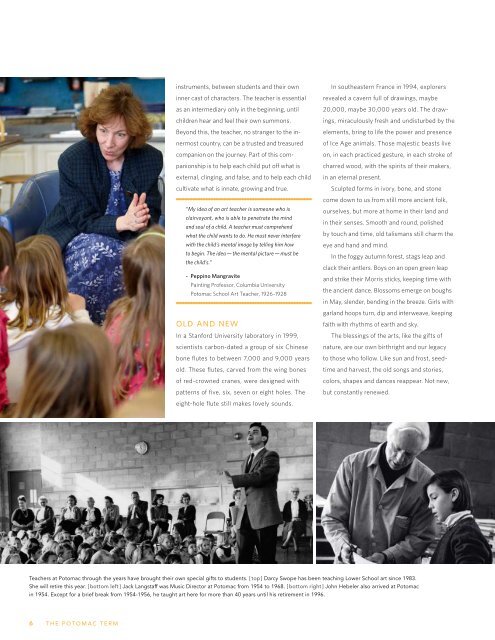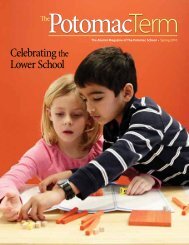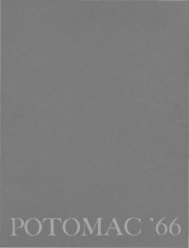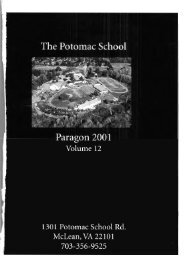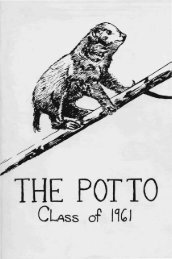Spring 2009 Potomac Term - Potomac School
Spring 2009 Potomac Term - Potomac School
Spring 2009 Potomac Term - Potomac School
You also want an ePaper? Increase the reach of your titles
YUMPU automatically turns print PDFs into web optimized ePapers that Google loves.
instruments, between students and their own<br />
inner cast of characters. The teacher is essential<br />
as an intermediary only in the beginning, until<br />
children hear and feel their own summons.<br />
Beyond this, the teacher, no stranger to the innermost<br />
country, can be a trusted and treasured<br />
companion on the journey. Part of this companionship<br />
is to help each child put off what is<br />
external, clinging, and false, and to help each child<br />
cultivate what is innate, growing and true.<br />
“My idea of an art teacher is someone who is<br />
clairvoyant, who is able to penetrate the mind<br />
and soul of a child. A teacher must comprehend<br />
what the child wants to do. He must never interfere<br />
with the child’s mental image by telling him how<br />
to begin. The idea — the mental picture — must be<br />
the child’s.”<br />
- Peppino Mangravite<br />
Painting Professor, Columbia University<br />
<strong>Potomac</strong> <strong>School</strong> Art Teacher, 1926-1928<br />
Old and New<br />
In a Stanford University laboratory in 1999,<br />
scientists carbon-dated a group of six Chinese<br />
bone flutes to between 7,000 and 9,000 years<br />
old. These flutes, carved from the wing bones<br />
of red-crowned cranes, were designed with<br />
patterns of five, six, seven or eight holes. The<br />
eight-hole flute still makes lovely sounds.<br />
In southeastern France in 1994, explorers<br />
revealed a cavern full of drawings, maybe<br />
20,000, maybe 30,000 years old. The drawings,<br />
miraculously fresh and undisturbed by the<br />
elements, bring to life the power and presence<br />
of Ice Age animals. Those majestic beasts live<br />
on, in each practiced gesture, in each stroke of<br />
charred wood, with the spirits of their makers,<br />
in an eternal present.<br />
Sculpted forms in ivory, bone, and stone<br />
come down to us from still more ancient folk,<br />
ourselves, but more at home in their land and<br />
in their senses. Smooth and round, polished<br />
by touch and time, old talismans still charm the<br />
eye and hand and mind.<br />
In the foggy autumn forest, stags leap and<br />
clack their antlers. Boys on an open green leap<br />
and strike their Morris sticks, keeping time with<br />
the ancient dance. Blossoms emerge on boughs<br />
in May, slender, bending in the breeze. Girls with<br />
garland hoops turn, dip and interweave, keeping<br />
faith with rhythms of earth and sky.<br />
The blessings of the arts, like the gifts of<br />
nature, are our own birthright and our legacy<br />
to those who follow. Like sun and frost, seedtime<br />
and harvest, the old songs and stories,<br />
colors, shapes and dances reappear. Not new,<br />
but constantly renewed.<br />
Teachers at <strong>Potomac</strong> through the years have brought their own special gifts to students. [ top ] Darcy Swope has been teaching Lower <strong>School</strong> art since 1983.<br />
She will retire this year. [ bottom left ] Jack Langstaff was Music Director at <strong>Potomac</strong> from 1954 to 1968. [ bottom right ] John Hebeler also arrived at <strong>Potomac</strong><br />
in 1954. Except for a brief break from 1954-1956, he taught art here for more than 40 years until his retirement in 1996.<br />
6 The <strong>Potomac</strong> <strong>Term</strong>


